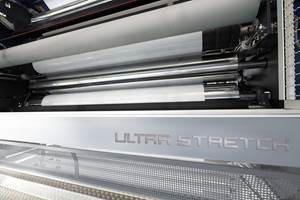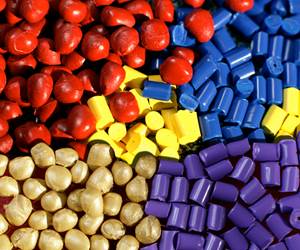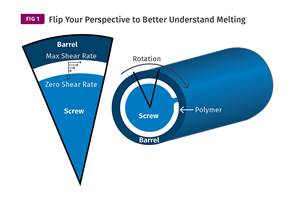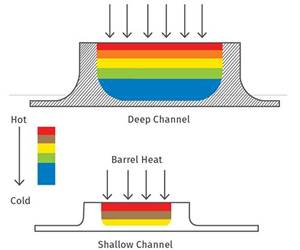Don’t Overlook the Feed Section
Extrusion Know How
Most extrusion screw designers often do not design the feed section with the same rigor as other sections. This is odd since nothing goes through the screw that doesn’t first go through the feed section.
Most extrusion screw designers often do not design the feed section with the same rigor as other screw sections. This is unfortunate—after all, nothing goes through the screw that doesn’t first go through the feed section.
For smooth-bore extruders, I define the feed section as the section before compression begins. (Grooved-barrel extruders have different design considerations and are not considered in this article.) Traditionally, the compression ratio has most often been used to determine feed-channel depth. The flight pitch is also a factor, but for simplicity the standard pitch is widely used due to difficulty in determining the ideal pitch. The length is often determined by a simple percentage of overall length or a fixed number of turns applying to all polymers.
Optimum channel depth is largely a function of the solid properties of the polymer, such as bulk density, frictional characteristics, and solids flow properties. However, the melt viscosity of the polymer also enters into the depth considerations—the lower the melt viscosity, the greater the feed depth required to maximize melting rate. The compressibility of the resin infeed material also has to be considered. So compression ratio has more than one meaning, and consequently is not a positive indicator for feed depth.
The best way to evaluate the solid properties is by relying on your experience with each polymer, along with some simple tests. Measuring the angle of repose gives a good indication of the internal friction coefficient of the material. Measuring the bulk density and comparing it with the channel volume determines how much mass the feed channels might hold, keeping in mind that the average pelletized polymer is 25-40% air by volume. Removing the air voids alone can necessitate a 1.25-2:1 compression ratio based on the channel volume.
If you couple that with experimentally determined feeding efficiency, you can calculate an estimated feed rate that should match or slightly exceed the desired output, thereby allowing for some variation in the polymer solid properties. If you’re processing recycled material, you’ve added another variable to this analysis. Finally, measuring the tendency of the material to pack can be done by putting it into a small plastic bag and squeezing it.
It takes a little experience to evaluate a single polymer, but it is easy to compare two different polymers. Polymers that pack easily will feed at higher efficiency than slippery ones. Obviously this is not a calculated value, but it does give a relative number to a known material. The frictional characteristics of the polymer with respect to the feed-throat surface at varying temperatures are usually determined by experience, although they can be measured with various kinds of equipment such as the Screw Simulator designed and built many years ago by Dr. Chan I. Chung, now professor emeritus at Rensselaer Polytechnic. This device is used by extrusion consultant Dr. Eldridge M. Mount III (emmount-technologies.com) as part of his services. Compressibility is related to the hardness and particle characteristics of the polymer, but also to the frictional forces that determine the pressure development in the solids-feeding area.
Determining the optimum flight pitch is almost exclusively a matter of experience and/or testing because of the complex interrelationship of many of the polymer solid parameters. In general, polymers with higher coefficients of internal friction tend to feed at higher rates with slightly longer pitch. That’s because their conveying angle is greater due to the greater particle-to-particle friction. Conversely, polymers with low internal coefficients of friction tend to feed better with a slightly shorter pitch. Regardless, there is no precisely fixed pitch for any polymer type because the conveying angle can vary within the same polymer due to particle geometry and randomness. However, the total range is only about three degrees either side of the standard pitch for solid polymer pellets, so this is heavily utilized and usually works OK.
The ideal length of the feed section requires consideration of the frictional characteristics and the compressibility, but is also heavily dependent on the thermal properties of the polymer. In addition to the transport function, the feed flights also have to compact the polymer to void air and form a solid polymer plug before appreciable melting can commence. This function is related to the solid properties of the material, including its hardness, along with the pressure development in the feed section.
Melting should be initiated before compression starts, or the resistance to pressure used to force the solid polymer into a smaller volume reduces the feed rate and can cause plugging, affecting output stability and screw wear. As an estimate for the feed length, I use the thermal diffusivity multiplied by the processing temperature (less any preheating) to give a good indication of the relative feed length before melting starts.
By that measure, for example, nylon 66 would require a feed section approximately 50% longer than LDPE for melting to be initiated. The determination of length is as important as the depth of the feed channels.
In summary, it’s difficult to develop a balanced screw design without knowledge of the feed material. I often request a small sample of the feed material to confirm that information. Balance between the solid feeding, melting, and melt pumping sections of the screw are important to achieve the best results, and that cannot be achieved without the appropriate feed-section design.
About the Author
Jim Frankland is a mechanical engineer who has been involved in all types of extrusion processing for more than 40 years. He is now president of Frankland Plastics Consulting, LLC. Contact jim.frankland@comcast.net or (724)651-9196.
Related Content
The Fundamentals of Polyethylene – Part 1: The Basics
You would think we’d know all there is to know about a material that was commercialized 80 years ago. Not so for polyethylene. Let’s start by brushing up on the basics.
Read MoreFundamentals of Polyethylene – Part 6: PE Performance
Don’t assume you know everything there is to know about PE because it’s been around so long. Here is yet another example of how the performance of PE is influenced by molecular weight and density.
Read MoreUnderstanding Melting in Single-Screw Extruders
You can better visualize the melting process by “flipping” the observation point so the barrel appears to be turning clockwise around a stationary screw.
Read MoreThe Importance of Barrel Heat and Melt Temperature
Barrel temperature may impact melting in the case of very small extruders running very slowly. Otherwise, melting is mainly the result of shear heating of the polymer.
Read MoreRead Next
See Recyclers Close the Loop on Trade Show Production Scrap at NPE2024
A collaboration between show organizer PLASTICS, recycler CPR and size reduction experts WEIMA and Conair recovered and recycled all production scrap at NPE2024.
Read MoreMaking the Circular Economy a Reality
Driven by brand owner demands and new worldwide legislation, the entire supply chain is working toward the shift to circularity, with some evidence the circular economy has already begun.
Read More.jpg;width=70;height=70;mode=crop)










